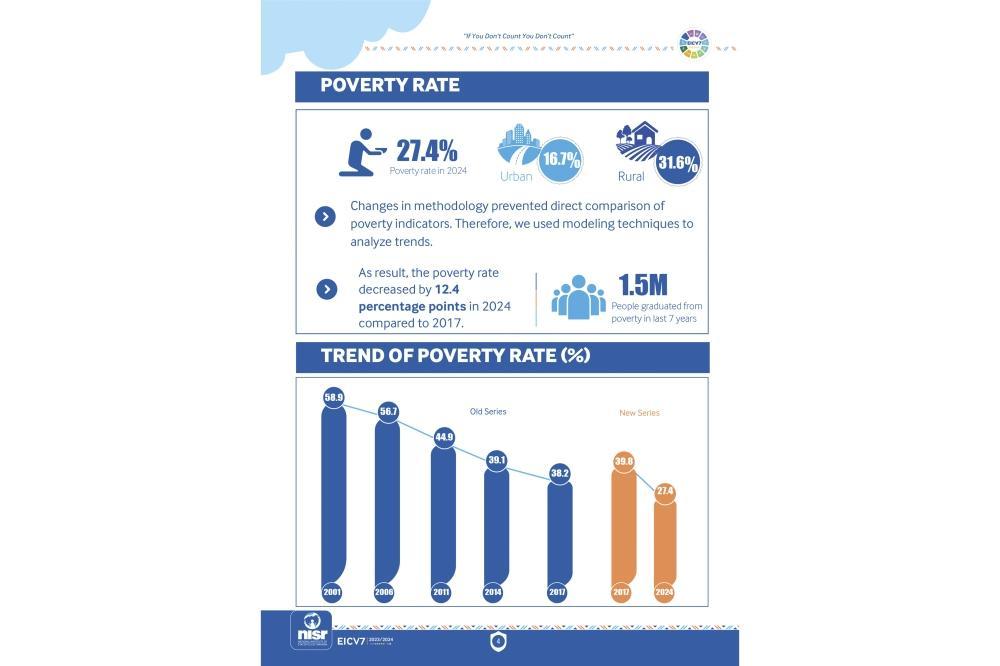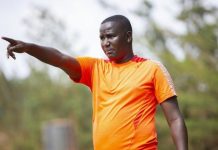Emmanuel Ntirenganya
Africa-Press – Rwanda. The National Institute of Statistics of Rwanda (NISR) on Wednesday, April 16, released the findings of its seventh Integrated Household Living Conditions Survey (EICV 7), which shows progress in several key areas.
They include poverty and extreme poverty reduction, and improvement in access to essential utilities such as electricity, clean water, and internet services.
Below are 10 key highlights from the survey:
1. Poverty and extreme poverty reduction
The survey report indicated that Rwanda recorded a significant decline in poverty over the past seven years, lifting more than 1.5 million citizens out of poverty, averaging 214,000 Rwandans emerging from poverty each year.
It showed that the overall poverty rate fell from 39.8 per cent in 2017 to 27.4 per cent in 2024, nationally, representing a drop of 12.4 percentage points.
Poverty in urban areas decreased from 18.8 per cent in 2017 to 12.7 per cent in 2024, a reduction of 6.2 percentage points, the report pointed out. Rural areas experienced a more significant drop, from 44 per cent to 31.6 per cent, indicating a reduction of 12.4 percentage points.
View this post on Instagram
A post shared by The New Times (@thenewtimesrwanda)
Extreme poverty fell from 11.3 per cent to 5.4 per cent – meaning that it was more than halved.
The survey conducted from October 2023 to October 2024 involved 15,066 households across all districts, representing more than 62,000 people, as a sample.
EICV 7 showed that there were almost 3.3 million households in Rwanda, comprising 964,000 urban areas, and more than 2.3 million in rural areas.
2. Electricity access improved
The EICV 7 also indicates improved social economic indicators such as access to electricity. A significant increase of household access to electricity was observed, from 34.4 per cent in 2017 to 72 per cent in 2024.
While presenting the survey findings on Wednesday in Kigali, Ivan Murenzi, Director General of the National Institute of Statistics of Rwanda, said with access to electricity more than doubling among Rwandan households in the last seven years, greater improvement was registered in rural areas.
“Access could just be in urban areas. But what you’ll notice is that we have actually more increment in rural areas whereby households accessing electricity [increased] from 25 per cent to 65 per cent,” Murenzi said.
“So that implies that the programmes being implemented in terms of access to basic services are well targeted. They are reaching people who really need them.”
3. Slight increase in households using improved drinking water
The survey data showed a nationwide increase in access to improved drinking water, rising from 87.4 per cent in 2017 to 89.7 per cent in 2024. The City of Kigali recorded the highest percentage of households with improved water access, increasing from 96 per cent to 98 per cent in the period under review, representing a two-percentage-point rise.
In contrast, Western Province, which ranks lowest, reported a decrease from 87 per cent in 2017 to 85 per cent in 2024.
4. Rise in mobile phone access
The survey also showed a rise in mobile phone ownership, with households owning phones increasing to 84.6 per cent in 2017 from 66.9 per cent in 2017. It specified that 94.1 per cent of urban households have access to phones compared to 80.6 per cent for rural households.
Regarding the type of such electronic communication devices, it indicated that 34 per cent of those households have smartphones – at national level.
Smartphone ownership stands at 37.4 per cent for male-headed households and 25.8 per cent for female-headed households, the survey showed, adding that 61.9 per cent of urban households own smartphones, which is far higher than 22.9 rate for rural ones.
Though the previous survey did not indicate the rate of households with smartphones – which can serve as the baseline for comparison purposes – in June 2023, the Minister of ICT and Innovation, Paula Ingabire, told senators that while 78 percent of Rwandans owned phones as of 2022, overall, only 25 percent had smartphones.
5. Internet access rises by 13 percentage points
The survey shows that 29.8 per cent of households in Rwanda have internet access at home compared to 17 per cent recorded in 2017.
This represents a significant improvement in connectivity, demonstrating progress in Rwanda’s digital transformation agenda. Urban households are significantly more connected, with 57 per cent reporting internet access at home, compared to 19 per cent of rural households.
Households in different types of habitats exhibit varying levels of connectivity. Modern planned urban areas report the highest access rates (78 per cent), while households in dispersed or isolated rural settlements have the lowest access (10 per cent), the survey shows.
6. Educational: More women completed secondary school
Educational attainment refers to the highest level of education that an individual has attained or completed. This is distinct from the level of schooling in which an individual is currently enrolled.
Nationally, the survey report showed, 8.9 per cent of the population aged 10 and above have no formal education, and most of these are over 40 years old.
The majority of the population, 62.9 per cent, only attended primary school, while 23.9 per cent have attended secondary school, and 4.3 per cent have had some university education.
These figures reflect the dominance of primary education as the most accessible level of schooling. Among males, 6.9 per cent have no education compared to 10.6 per cent of females. While relatively more males than females have just primary education (66 per cent versus 61 per cent), more females than males finished their education at the secondary level (25 per cent versus 23 per cent).
However, more males than females have completed some university education (4.9 per cent compared to 3.7 per cent), although slightly more young women than men (aged 15-24) report having some university education.
Economic status is closely correlated with educational attainment. In the highest consumption quintile (the group of the wealthiest households), 19.7 per cent of males and 15.7 per cent of females have had some university education. Conversely, in the lowest quintile (that of the poorest household group), these rates drop to near negligible levels (0.1 per cent for males and 0.2 per cent for females).
7. Repetition rates in primary school
Repetition rates provide a key measure of the efficiency of the education system. They indicate the proportion of students who, for various reasons, are unable to progress to the next grade within a given academic year.
The survey looked at the proportion of students aged 7 and above attending a grade in primary school in 2022/2023 who repeated the same grade in 2023/2024.
As per the report, nationally, the repetition rate in primary schools is 21 per cent. Notably, boys are more likely to repeat (24 per cent) than girls (18 per cent), indicating gender disparities in progression rates.
Urban and rural differences are evident, with rural areas recording a higher repetition rate of 22 per cent compared to 17 per cent in urban areas.
Among socioeconomic groups, repetition rates are highest in the poorest quintile (26 per cent) and progressively decline with wealth, reaching a low of 11 per cent in the wealthiest quintile. This pattern underscores the role of economic disadvantage in hindering educational progression.
For secondary education, the survey showed repetition rates among students aged 13 years and above.
Nationally, the overall repetition rate was 8.4 per cent, with females showing a higher rate of 10 per cent compared to males at 7 per cent. Urban areas have a lower repetition rate of 6 per cent compared to 10 per cent in rural areas.
Repetition rates decrease with increasing household wealth. The second-poorest quintile has the highest repetition rate at 12 per cent, while the richest quintile records the lowest rate at 5 per cent.
8. Literacy and numeracy
In the survey, literacy was defined as the ability to read and write a simple note, measured through self-assessment.
It assessed literacy rates among individuals aged 15 and above.
At the national level, the literacy rate stood at 75.8 per cent, with higher rates for males (78.4 per cent) than females (73.6 per cent). This indicates a gender gap in literacy rates across Rwanda.
Urban areas exhibit significantly higher literacy rates (87 per cent) compared to rural areas (71 per cent).
The literacy rate for individuals aged 15–24 is 87.7 per cent, with a higher rate for females (91 per cent) over males (85 per cent). This gender difference highlights Rwanda’s achievements in promoting female education and literacy among youth.
9. Income inequality
Income inequality is measured by looking at how resources are distributed. Gini coefficient is a measure of 0 to 1 used in measuring inequality, with zero indicating perfect equality and one indicating perfect inequality. The survey showed that inequality in Rwanda was 0.37 in 2024, which indicates moderate inequality, according to the statistics office.
Inequality is wider in urban areas (0.44) than in rural areas (0.26).
The City of Kigali has the highest level of inequality (0.44), while Northern Province has the lowest (0.27).
10. Clean cooking standards
The living conditions survey showed that more Rwandan households have access to clean cooking fuels (gas and electricity), although the share remains low compared to those using charcoal and firewood.
Nationwide, the number of households using clean cooking fuels increased from 1 per cent in 2017 to 5 per cent in 2024. In urban areas, the numbers are more than three times the national average.
Up to 17 per cent of urban households used clean cooking fuels in 2024, an increase from 5 per cent reported in 2017. In rural areas, 1 per cent of households used clean cooking fuels in 2024, from just 0.2 per cent in 2017.
Source: The New Times
For More News And Analysis About Rwanda Follow Africa-Press






